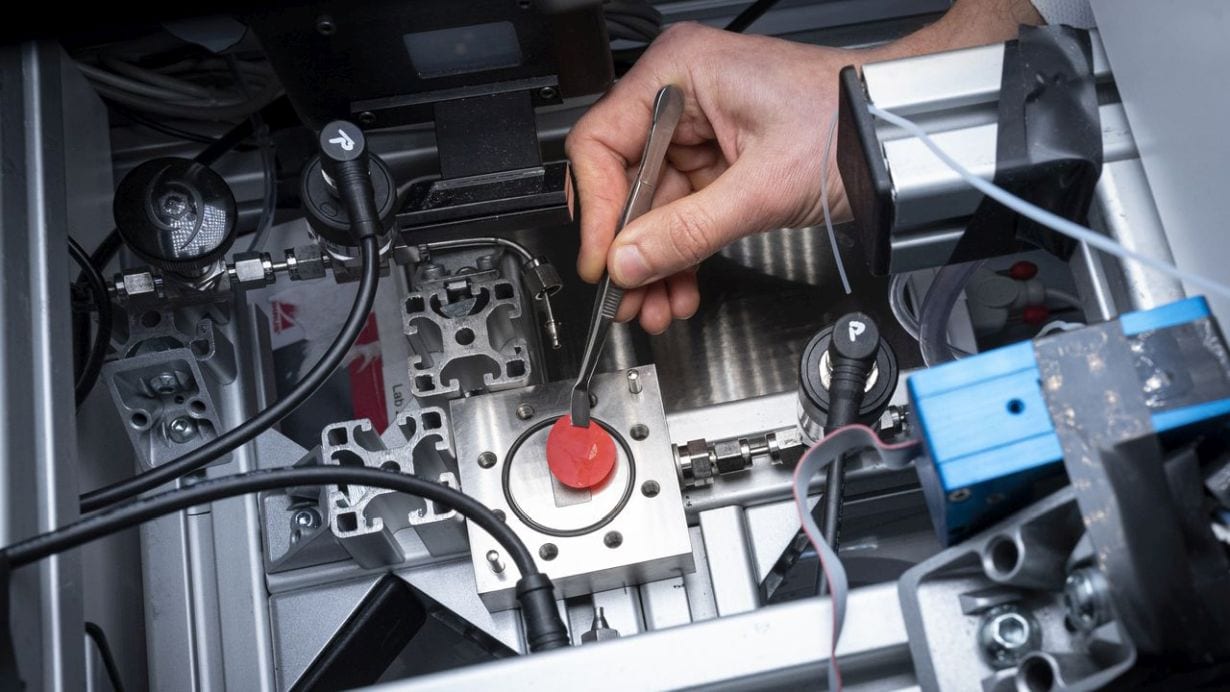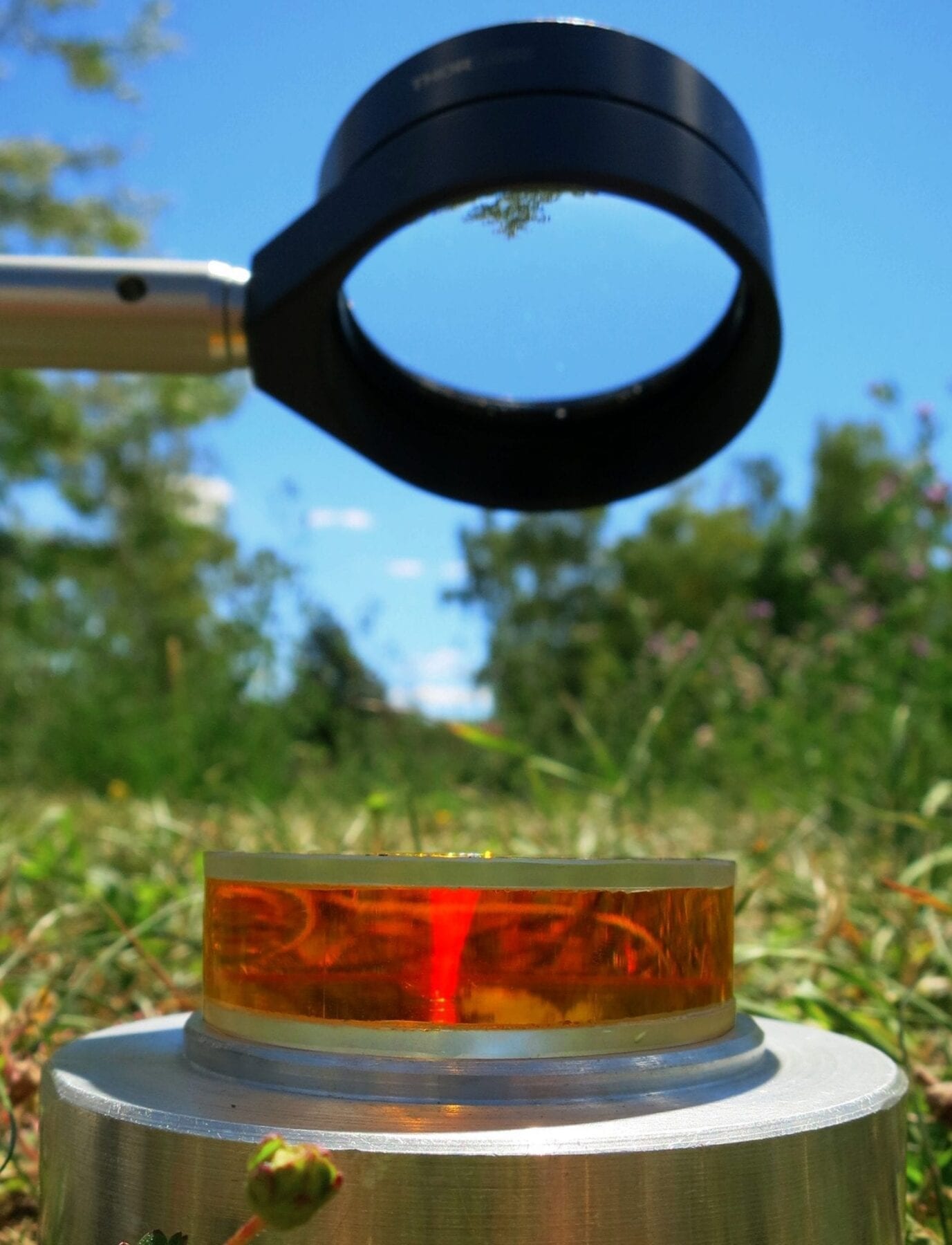
Insertion of the photocatalytic membrane into the membrane reactor.
(Photo: Markus Breig, KIT)
KIT Researchers Developed a New Method to Remove Micropollutants Using a Photocatalytic Membrane and Visible Light.
Micropollutants such as steroid hormones contaminate drinking water worldwide and pose a significant threat to human health and the environment even in smallest quantities. Until now, easily scalable water treatment technologies that remove them efficiently and sustainably have been lacking. Scientists at the Karlsruhe Institute of Technology (KIT) developed a new chemical process for removing hormones. It takes advantage of the mechanisms of photocatalysis and transforms the pollutants into potentially safe oxidation products. The team reports on this in the scientific journal Applied Catalysis B: Environmental.
Organic pollutants such as pharmaceuticals, pesticides, and hormones – even at nanoscale concentrations – contaminate drinking water in a way that poses significant risks to humans, animals, and the environment. In particular, the steroid hormones estrone, estradiol, progesterone, and testosterone can cause biological damage in humans and wildlife. The European Union has therefore set strict minimum quality standards for safe and clean drinking water, which must also be taken into account in the development of new technologies for water treatment. “The challenge for science is to develop more sensitive methods to target the hormone molecules,” says Professor Andrea Iris Schäfer, Head of the Institute for Advanced Membrane Technology (IAMT) at KIT. The main problem is that steroid hormones are very hard to detect in water. “There is one hormone molecule for every quintillion water molecules. This is an extremely low concentration,” explains the expert.
Detecting – and Removing – Micropollutants
With conventional water treatment technologies, wastewater treatment plants can neither find nor remove micropollutants. Researchers at the IAMT and the KIT Institute of Microstructure Technology (IMT) are therefore working on new methods to not only detect and measure micropollutants, but also remove them. A new, photocatalytic process proves to be promising. The scientists coated a commercially available large-pore polymer membrane with Pd(II)-porphyrin, a palladium-containing, light-sensitive molecule that can absorb visible radiation. Exposure to radiation with simulated sunlight initiates a chemical process that produces so-called singlet oxygen, a highly reactive oxygen species. The singlet oxygen specifically “attacks” the hormone molecules and converts them into potentially safe oxidation products. “It is crucial that we coat the surface of each pore with the photosensitizer molecule, increasing the surface area of attack,” explains Roman Lyubimenko, a scientist at IAMT and IMT.
Significant Reduction of the Estradiol Concentration
The chemical decomposition of steroid hormones and the filtration of other micropollutants can be realized in a single module. With this process, filtering of 60 to 600 liters of water per square meter of membrane is possible in one hour. The scientists were able to reduce the concentration of estradiol, the most biologically active steroid hormone, by 98 percent from 100 to 2 nanograms per liter. “This means that we are already very close to the EU target value of one nanogram per liter,” emphasizes Schäfer. The next goal of the research team is to further optimize the photocatalytic process and transfer it to a larger scale. Open issues are to find out how much light intensity and how much porphyrin will be needed and whether the costly palladium from the platinum group of metals can be replaced by other metals.
Original Article: Water Treatment: Removing Hormones with Sunlight
More from: Karlsruhe Institute of Technology
The Latest Updates from Bing News & Google News
Go deeper with Bing News on:
Scalable water treatment technologies
- KIT researchers develop18.2%-efficient perovskite solar cell via scalable inkjet process
Researchers at Karlsruhe Institute of Technology (KIT) have developed a scalable two-step evaporation and inkjet process for perovskite thin-film solar cells. The new technique reportedly enables to ...
- Seed treatment, without compromise? Cold plasma is ready for prime time, says Clean Crop Technologies
Clean Crop Technologies has launched a commercial cold plasma seed treatment facility, and signed $3.4m in purchase orders, says the startup ...
- Exploring Electrochemical Ozone Production at the Molecular Level
Image Credit: John Keith In the future, centralized chlorine treatments currently employed in urban centers or rural communities may give way to scalable electrochemical ozone production (EOP) ...
- The Clues for Cleaner Water
By using experimental electrochemical analyses, mass spectrometry, and computational quantum chemistry modeling, the researchers created an 'atomic-scale storyline' to explain how ozone is generated ...
- Engineers solve 'catalysis vs corrosion' mystery in electrochemical ozone production
Researchers at the University of Pittsburgh and Drexel University in Philadelphia, along with Brookhaven National Laboratory, are working to solve a multipart mystery to make water disinfection ...
Go deeper with Google Headlines on:
Scalable water treatment technologies
[google_news title=”” keyword=”scalable water treatment technologies” num_posts=”5″ blurb_length=”0″ show_thumb=”left”]
Go deeper with Bing News on:
Removing micropollutants
- How to Remove Drywall Anchors
However, it’s that same reliable grip that makes it tough to remove a wall anchor from the wall when you want to relocate that large mirror or an enormous family portrait. Are you painting a ...
- How Much Does Shrub Removal Cost In 2024?
Most homeowners will pay between $400 and $1,150 for bush removal, and professional arborists or tree service companies typically charge $50 to $70 per hour. Depending on the size and type of ...
- How Much Does Junk Removal Cost?
Junk removal companies come to your home and pick up most types of junk located throughout your house or yard. Junk removal companies combine several customers’ loads in one trash run.
- How to remove a login password on Windows 11
But there are some instances where you might want to remove a login password in Windows. Before we get started, there are some important things we'd like you to bear in mind. If you’ve signed ...
- Removing PFAS from public water systems will cost billions and take time – here are ways you can filter out harmful ‘forever chemicals’ at home
We explore new technologies to remove PFAS from drinking water and to handle the PFAS waste. Here’s a glimpse of the magnitude of the challenge and ways you can reduce PFAS in your own drinking ...
Go deeper with Google Headlines on:
Removing micropollutants
[google_news title=”” keyword=”removing micropollutants” num_posts=”5″ blurb_length=”0″ show_thumb=”left”]










